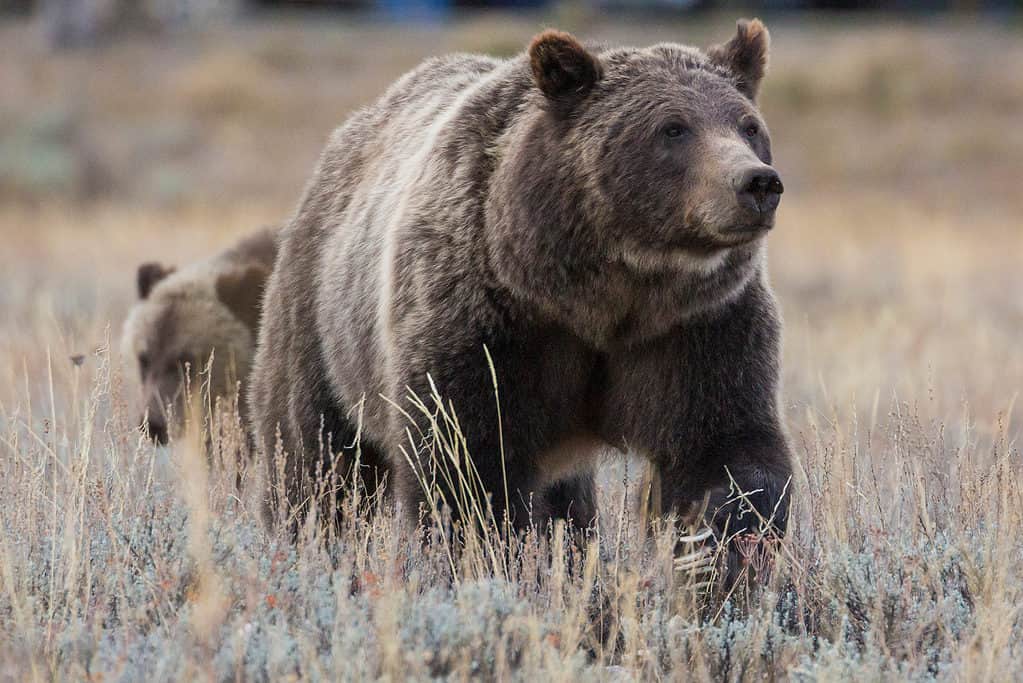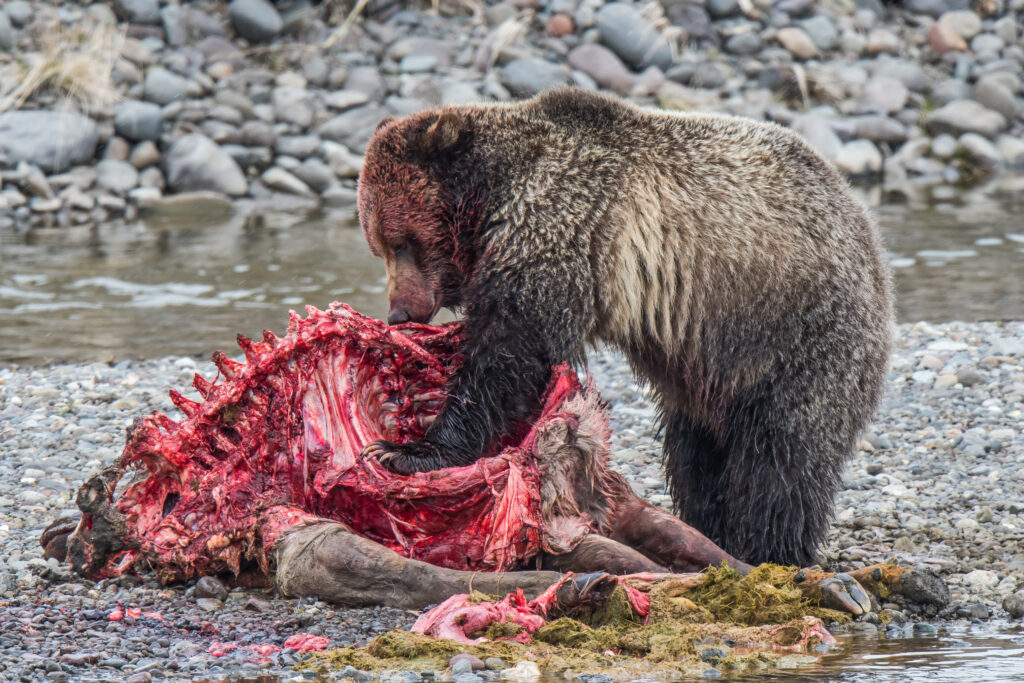Unless you’re there for the scientific purpose of observing the differences between male and female grizzlies, you probably won’t stick around to note the specific characteristics. Who could blame you? It’s safer to learn the differences from the safety of your mobile device, laptop, or desktop PC.
One thing is for sure, grizzly bears are large animals, oftentimes both intimidating and strangely adorable (assuming you like their warm, perpetually happy-looking faces. Grizzlies aren’t the largest of the species, but they are beautiful and terrifying in their way. The raw power of the animal is an expression of nature’s given physical form.
As fascinating as grizzly bears are, however, most people couldn’t tell you the difference between a male and a female. Unless, of course, there is a small line of cubs following her around, it’s not immediately obvious. But, for the discerning grizzly enthusiast, there are subtle differences that are worth taking note.
Differences Between Male and Female Grizzly Bears

Female grizzly with a cub.
©BlueBarronPhoto/Shutterstock.com
The most obvious difference between the two is their sizes. As with most animals (but not all), the male is bigger. A male grizzly, weighs anywhere between 400 and 600 pounds, while a female with females weighing between 300 and 450 pounds.
In Canada, grizzlies are a little bigger and weigh more, thanks to Bergman’s Rule. Bergman’s Rule indicates that the size of a species is directly related to the climate. In this case, the colder the climate, the bigger the bear. In general, add 50 to 100 pounds to grizzly bears in Canada.
1. Head and Ears
One of the lesser-known differences between male and female grizzlies is their ear size. Male grizzlies have smaller ears and are wider apart. This makes sense because the male grizzly has a larger head than a female. Females have larger ears that are closer together.
Someone who doesn’t know what to look for will probably catch the difference, but only if the two are standing together. A male grizzly’s head is squarish and large, while a female’s head is smaller and narrow. Her muzzle tapers off at a sharper angle than her male counterpart.
Despite the differences in head size, the males often look smaller, mostly because of their size in proportion to their heads. A distinction worth remembering, so you don’t confuse the two. Also, the male appears to have a sort of valley running down the center of its head. This is because of the size of its facial muscles. Female heads are rounder, with no distinctive valley down the center.
2. Shoulder-Width and Shape
Male grizzly bears are stockier, with wider shoulders behind a noticeably smaller head. The female’s shoulders are nearly the same width as her head, give or take a few inches. If you’re facing her head on (no pun intended), her head should eclipse her shoulders.
Facing the male, you will see his shoulders flanking his head, despite the large size of the latter.
3. Differences in Leg Size
Leg size is one of the more notable differences between male and female grizzlies. Males have much longer legs, while females have shorter legs that are nevertheless smaller and more rounded. Males have a larger rump and abdomen than females, which is typical, considering their overall size differences.
4. Behavioral Differences in Male and Female Grizzlies

Grizzly bear hitting the road after snowfall.
©Paul Knowles/Shutterstock.com
Both male and female grizzly bears are far more reclusive than Hollywood and various news stories lead people to believe. Bear attacks are rare, and bears will often move away from humans. It’s not that they’re scared of us per se, but more like they don’t want to mess with something they don’t immediately recognize and understand.
Both the male and the female are also solitary unless they get together for breeding. Once the act is done, the male usually leaves and the female raises the cubs. This leads us to one of the more interesting differences between male and female grizzlies.
Females are the more aggressive of the two when the cubs are involved, for completely understandable reasons. Without cubs, the male doesn’t separate himself from the female very much, in terms of aggression. However, males are predominately the ones involved in predatory behavior where humans are involved.
When it comes to going to the bathroom, the difference between the two is very noticeable. Females urinate behind their legs. Males urinate forward and between or in front of their legs. If you spot a male at the right angle, you may observe that it has a penis sheath, even though it’s not always easy to spot.
5. When Cubs are Involved
Of all the differences between male and female grizzlies, cubs tagging along for the ride is a dead giveaway. The male does not stick around to raise or defend the cub. The cubs will always be with a female grizzly.
Cubs will go on to live independently of their mother but only after 2 to 4 years. Four years is usually a stretch, but it happens from time to time. Female grizzlies that have cubs with them are usually between 3 and 8 years of age. Although a female grizzly will often live for a quarter of a century, 8 years is the cutoff date for most.
Of course, where nature is concerned, there are always exceptions to the rule. Consider 3 to 8 years to be a “soft rule”.
6. Hibernation Differences Between Male and Female Grizzlies
South of Canada, grizzlies spend an average of 4 to 6 months inside their dens, hibernating. The difference between male and female grizzlies is in how long they hibernate. Females hibernate the longest, especially when she has cubs along for the ride. Males hibernate for shorter periods, closer to the 4-month timeframe than females.
Females generally hibernate longer because It’s how she’s built, and it’s an instinctive matter, at least in theory. The reasoning is the growth, health, and eventual maturity of the cubs. It’s thought that females have to hibernate longer to promote the growth of the cubs. And, it serves as a pseudo-defense mechanism. Since cubs spend more time in a den, they spend less time exposed to whatever nature has to offer, good and bad.
7. Dietary Differences in Male and Female Grizzlies

Grizzly feasting on an Elk in Yellowstone.
©Bobs Creek Photography/Shutterstock.com
Grizzly bears are omnivores, but they are thought of as opportunistic. Meaning, that they will go for the best opportunity that presents itself, whether that’s meat or veggies. As it happens, the most opportunity-rich food for grizzlies seems to be graminoids, since they consume it for roughly 60% of their diet.
Surprisingly, grizzlies eat an awful lot of ants. If you have ant hills in your backyard, consider hiring a grizzly. They will decimate your problematic ant population. Ants come in a distant second behind graminoids, followed by pine seeds, clover, and dandelion.
You have to drop to the 6th spot to find the first meat item on a grizzly’s diet, which is elk. Understandably, grizzlies probably have a harder time finding, chasing, and capturing elk than they do ant beds and graminoids. Overall, however, the differences in male and female grizzlies are few and far between when considering their daily diet.
Both male and female grizzly bears increase their food intake drastically in preparation for hibernation season. If there is a feeding difference between the two, it’s the fact that males hibernate less, so they consume more on an annual basis. Male grizzlies also have a higher percentage of meat in their diets, though they tend to have a higher percentage of everything, with the ratio remaining roughly the same.
Final Thoughts
Once they’re all laid out, the differences between male and female grizzlies appear to be more pronounced. Of course, they’re both still grizzlies, which means they’re large, intimidating, eat a lot, sleep for months, and spend a lot of time wandering the wilderness alone.
If you ever spot a male or a female grizzly, only ever observe them from a safe location or a safe distance. Be sure to carry bear spray with you where grizzlies are known to tread. There’s nothing quite as incredible as observing these magnificent animals in their environment. But stay safe while you do, so you have the opportunity to do so again and again.
The photo featured at the top of this post is © Andrea C. Miller/Shutterstock.com
Thank you for reading! Have some feedback for us? Contact the AZ Animals editorial team.







